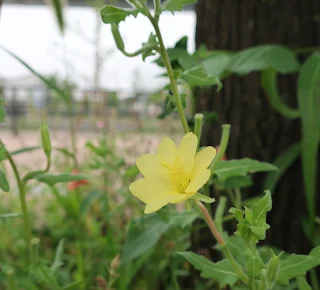Japanese follows English. 英語の後に日本語が続きます。
Can you see something green in the photo below? That's a feijoa fruit which I found several days ago and which taught me an important lesson: LOOSE LIPS SINK SHIP.
 |
| Feijoa flower and fruit フェイジョアの実 |
 |
Pineapple guava flower and fruit
パイナップルグアバの実 |
That day, at around 6 a.m., I was looking for feijoa or pineapple guava fruits. I had first seen feijoa flowers and
written about them early June and at that time, the feijoa trees didn't bear fruits. So, that morning, I was in front of the trees, looking for the fruits when barked by a toy poodle.....
A little surprised, but I ignored it, keeping looking for the fruits. I don't like toy poodles so much and besides, I was enjoying the solitude. But the owner, a man in his 50s or 60s, coming to me and telling the dog as if he had been speaking to a baby, "Come here. She's looking at flowers!" This got me into an awkward position that I had to say something to him.
So, I said, "This is feijoa," which put me in a more awkward position because he said "I KNOW," bossily, completely different attitude toward the dog.
OMG🤐! Is he a Japanese jerk, i.e., a male in his 50s or older with an inflated ego who can't have a casual chat with anyone, always speaking in a condescending manner to those younger than himself and his wife? It's easy to tell such a jerk in Japan because they don't use honorific expression, such as "desu" or "masu," to those younger or women (even if they are complete strangers), although changing the way they speak when talking to someone senior to him or of a higher position...
Fortunately, however, I know how to deal with such men - keep talking! Because these men don't like talkative and assertive women. And I was right. When I started to talk more about feijoa, such that it has another name, "pineapple guava" and its fruits taste like pineapple, apple and mint, blah, blah, blah, he got irritated, starting again to say something to not me but the dog and walked away....
A lesson learned. Going forward, I WILL KEEP MY MOUTH SHUT to ensure that my precious early morning time won't be ruined.
(If you wish to post your comment but don't have a Google account, select "anonymous" from the drop down menu titled "comment as"!)
6月上旬、
フェイジョアの花について書いたとき、実がなることを知りました。そこで先日、なってるか確認しに行ったら、トイプードルが吠えてきました。
実は私、トイプードルをあまり好きではありません。しかも結構集中して実を探してました。なのでスルーしてたら飼い主の男性が寄って来て「だめだめ、お花見てるんだから」とそのトイプーに赤ちゃん言葉で話し始めたんです。あ~あと思ったのですが、何か言わなくちゃ失礼だと思い「これフェイジョアっていうんです」と言いました。そしたら「知ってるよ🤨怒!」 態度激変😠
は~、やってもうた。。。 いるんですよね、こういう「目下(女子供)の者」に常に「上から目線」で話す人。でも大丈夫。私知ってるんです、対処法。黒柳徹子になって、向こうが逃げるまで話し続けるんです。ですから言いました。「それでですね、パイナップルグアバとも言いまして、パイナップルとリンゴとミントの味がするんです。。。 ペラペラペラ」そしたら大成功! また犬に話し始めて、行って(逃げて🤪)しまいました。
教訓:雉も鳴かずば撃たれまい。朝の貴重な時間をダメにしたくなければ口は閉じておきましょう。
(Google アカウントを持ってない方は、コメント記入後に「Google アカウント」をクリックし、「匿名」か「名前/URL」を選択してからご記入ください!)




















































